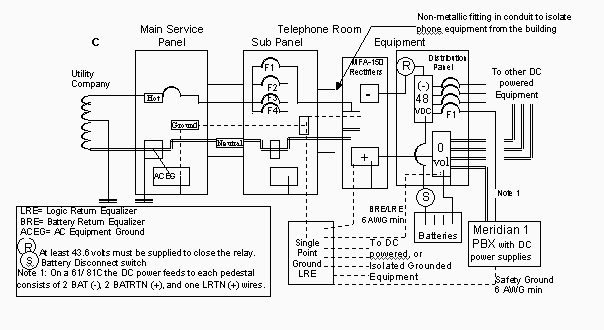Assuring Power Quality for
Meridian 1 Installations
Effective grounding (NEC 250-2): Establishes a zero voltage reference for logic circuits in electronic equipment. The fault path shall be permanent and electrically continuous, shall be capable of safely carrying the maximum fault likely to be imposed on it, and shall have sufficiently low impedance to facilitate the operation of the over-current protective devices under fault conditions. All of the grounding conductors (except the equipment ground to the MFA-150) associated with the Meridian 1 system (LRE, Battery Return, and #6 Safety Ground) are part of the UTILIZATION EQUIPMENT, not the PREMISES WIRING SYSTEM and, as such, do NOT fall under the requirements of the National Electrical Code.
| References:
1999 edition of the National Electric Code (NEC) |
Installation
Grounding Electrodes:
Can be a grounded steel structure, reinforced concrete, or grounding rods. Each time you double the number of electrodes or double the depth, resistance is reduced approximately 40%. All earth grounds for the same building shall be bonded to prevent a potential between grounds. It may be necessary to bond separate buildings if metallic data cable (ex. RS232) is used between the buildings (or use nonconductive fiber optic cable).
Single Point Ground:
Nortel requires all grounding conductors from the telephone system to terminate at a single point including the following:
- All AC branch circuit equipment grounds supplying Meridian 1 equipment.
- The personal hazard or Safety grounding conductor.
- The Battery Return Equalizer (BRE) ground for DC systems.
- The Logic Return Equalizer (LRE) grounding conductor.
Auxiliary equipment not on the same isolated ground, shall be isolated with fiber optic cables.
Bonding of Neutral and Ground in Isolated Ground Systems:
• Neutral and Ground are only bonded at the Main Service Panel and at all separately derived systems (ex. secondary of an Isolation Transformer or a Generator or Inverter). Each bond is then connected to a grounding electrode, either a grounded steel structure, or grounding rod. Do not bond at sub-panels or at receptacles. Improper grounding of Neutral and Ground can cause a voltage potential between grounds thereby causing current flow on grounds and disrupting Meridian 1 performance.
| 1999 National Electrical Code (NEC) reference:
250-24-5: Requires that no grounding connection be made to any
neutral downstream from the main neutral-ground bonding point (this would put some of the
return load current on the ground). |
• Metallic conduit is encouraged because it shields against Radio Frequency Interference (RFI). However, metallic receptacles that are connected to conduit will pick up noise and interference from other equipment in the building. The requirement to ground metallic boxes and conduit can be accomplished with the conduit runs back to the Main Service panel. To isolate the receptacle ground from boxes/conduit, use isolated receptacles (orange color) or non-metallic boxes. To isolate equipment from conduit use non-metallic fittings.
The isolated ground wire run between the Meridian equipment and the grounding electrode should be insulated to avoid contact with other grounds. On a DC system the isolated ground can be run separate from the hot and neutral wires. On an AC system, the grounding conductor must be run with the hot and neutral wires to cancel reactance.
| 1999 National Electrical Code (NEC) references:
250-146 Connecting Receptacle Grounding Terminal to Box. 250-96 Isolated Grounded circuits. |
• Use a Common Ground reference for the entire building.
| 1999 National Electrical Code (NEC) reference:
250-30 Common Grounding Electrode |
Correct Isolated Ground Installations:
Three illustrations of correct Isolated Ground Installations follow. Although all three examples use a single hot wire, in the USA rectifiers can be wired using two hot leads for a total of 208 or 220 volts.

